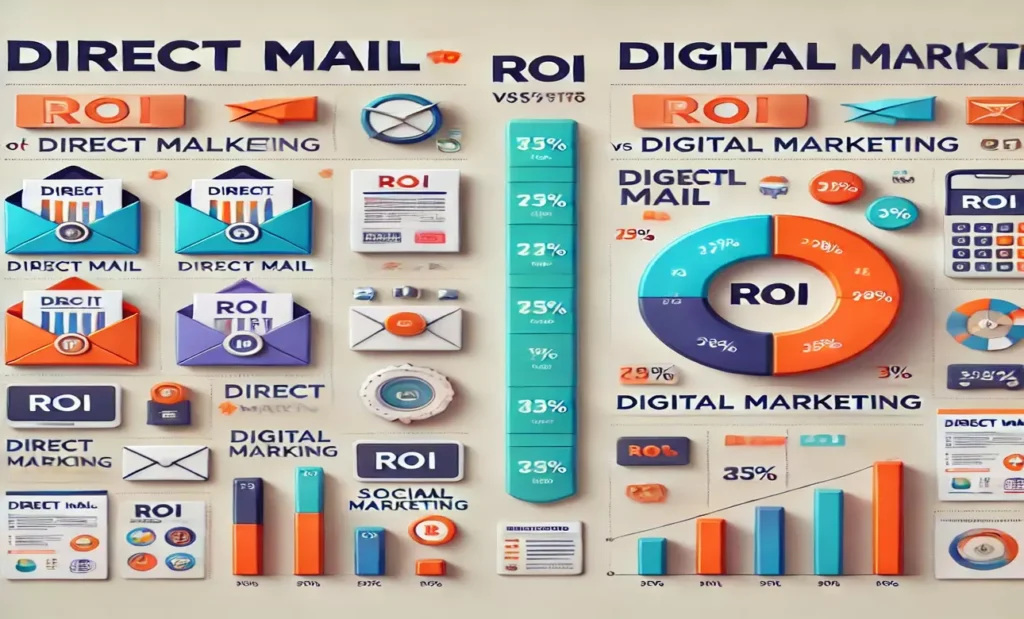Direct Mail Campaign Costs: A Guide to Budgeting and ROI

Direct mail campaigns, a long-standing pillar of marketing strategies, provide a tangible way to connect with potential customers. Understanding the costs of these campaigns is crucial and empowering for businesses aiming to maximize their return on investment (ROI). This article will explore the key factors that shape direct mail campaign costs, offering practical tips and strategies for managing and reducing these expenses, putting you in control of your marketing budget.
- Understanding Direct Mail Campaigns
- Components of a Direct Mail Campaign
- Factors Influencing Direct Mail Campaign Costs
- Mailing List Costs
- Design and Copywriting Costs
- Printing Costs
- Postage and Delivery Costs
- Strategies for Reducing Direct Mail Campaign Costs
- Case Studies of Direct Mail Campaign Costs
- Evaluating the ROI of Direct Mail Campaigns
- Common Pitfalls and How to Avoid Them
- Future Trends in Direct Mail Campaign Costs
- Conclusion
- FAQs About Direct Mail Campaign Costs
Understanding Direct Mail Campaigns
What is a Direct Mail Campaign?
A direct mail campaign involves sending physical promotional materials, such as postcards, brochures, or catalogs, directly to a targeted list of recipients. These campaigns are designed to promote products, services, or brand awareness.
History and Evolution
Direct mail has undergone a significant evolution from its early days of mass mailing to today’s highly targeted and personalized approaches. This transformation, driven by data analytics and printing technology advancements, has made direct mail more effective and efficient, keeping you informed and up-to-date with the latest in marketing strategies.
Why Businesses Use Direct Mail Campaigns
Direct mail continues to be favored due to its personal approach, ability to be precisely targeted, and often results in higher response rates compared to digital marketing methods. Moreover, it helps businesses differentiate themselves in a saturated digital landscape.
Components of a Direct Mail Campaign
Mailing List
The success of a direct mail campaign is primarily determined by the quality of the mailing list. A well-segmented and up-to-date list ensures the right message reaches the right audience.
Design and Copywriting
Effective design and compelling copy are critical for capturing the recipient’s attention and driving action. Investing in professional design and copywriting can significantly impact the campaign’s success.
Printing Costs
Printing is a significant component of direct mail costs. Choices regarding paper quality, printing techniques, and materials volume can affect the overall expense.
Postage and Delivery
Shipping fees typically represent the largest expense in a direct postal marketing initiative. Selecting the appropriate type of postage and taking advantage of bulk mailing discounts can help manage these expenses.
Tracking and Analytics
Monitoring the effectiveness of direct mail campaigns is not only a best practice; it’s crucial for assessing ROI and informing data-driven decisions. Fortunately, various tools and services are available to track response rates and other vital metrics, ensuring your campaign stays on the right track.
Factors Influencing Direct Mail Campaign Costs
Quality of Mailing List
A high-quality, targeted mailing list is more expensive but can lead to better campaign results. Costs may differ depending on the source and accuracy of the list.
Design Complexity
The complexity and creativity of the design can drive up costs. Simple designs are cheaper, but investing in unique and eye-catching designs can improve response rates.
Printing Quality and Quantity
Higher quality materials and finishes, such as glossy paper or custom die-cuts, increase costs. Printing in larger quantities can reduce the cost per piece.
Type of Postage
Different postage options, such as first-class or standard mail, have varying costs. Bulk mailing rates and pre-sorted mail can offer significant savings.
Additional Services
Personalization, tracking, and other added services can enhance a campaign’s effectiveness and increase costs.
Mailing List Costs
Purchasing vs. Renting Lists
Purchasing a mailing list provides long-term use but requires a higher upfront investment. Renting lists are cheaper initially but may offer different long-term values.
Costs Associated with List Segmentation
Segmenting lists based on demographics, behaviors, or other criteria can increase costs but enhance targeting and effectiveness.
Cleaning and Maintaining Lists
Regularly updating and cleaning mailing lists to remove duplicates and outdated information is essential to maintain accuracy and reduce wasted mailings.
Design and Copywriting Costs
Hiring Professional Designers and Copywriters
Professional design and copywriting services can be costly but are often worth the investment for creating compelling mail pieces.
DIY Design Tools and Their Costs
Using online design tools can be a more affordable option, though it may require more time and effort from the business.
Tips for Cost-Effective Design and Copywriting
- Keep designs simple.
- Focus on a robust and persuasive copy.
- Use templates to save on design costs.
Printing Costs
Types of Printing
For smaller print, the cost-effective thing tends to be more cost-effective. On the other hand, offset printing is more suitable for larger quantities because it offers lower costs per piece.
Cost per Piece vs. Bulk Printing
Printing larger quantities reduces the cost per piece. Businesses should balance the volume with their budget and expected response rates.
Factors Affecting Printing Costs
- Paper quality: Premium paper tends to cost more.
- Finishes: Glossy, matte and other finishes add to the cost.
- Special features: Die-cuts, embossing, and other customizations increase expenses.
Postage and Delivery Costs
Types of Postage
Choosing between first-class, standard, or bulk mailing impacts costs. First class is faster but more expensive, while standard and bulk options offer savings.
Discounts and Bulk Mailing
Using bulk mailing rates and pre-sorted mail can significantly reduce postage costs. Businesses should explore these options to save money.
International Mailing Costs
Mailing internationally is more expensive. Companies need to consider the advantages in relation to the increased expenses when aiming for international markets.
Tracking and Analytics Costs
Importance of Tracking and Analytics
Monitoring the performance of direct mail campaigns is vital and reassuring for measuring return on investment and making well-informed, data-driven decisions. Various tools and services are available to track response rates and other essential metrics so you can be confident in your campaign’s effectiveness.
Tools and Services for Tracking
Various tools and services, such as QR codes, personalized URLs, and response tracking software, are available to monitor campaign performance.
Costs of Different Tracking Methods
Tracking methods vary in cost, from affordable QR codes to more expensive personalized URLs and tracking software.
Strategies for Reducing Direct Mail Campaign Costs
Optimizing Mailing Lists
Ensure mailing lists are accurate and well-segmented to reduce wasted mailings and improve targeting.
Using Cost-Effective Printing Options
Choose options that balance quality and cost, and consider bulk printing for more extensive campaigns.
Leveraging Bulk Mailing Discounts
Leverage volume discounts and pre-sorting services to minimize shipping expenses for your direct mail campaign.
Employing Effective Design Strategies
- Use simple, impactful designs.
- Minimize the use of costly finishes and bespoke customizations.
- Focus on clear and persuasive copy.
Case Studies of Direct Mail Campaign Costs
Small Business Example
A local bakery promoted a new product using a targeted mailing list and simple design, balancing costs with a high response rate.
Medium-Sized Business Example
A regional retail chain executed a direct mail campaign with a moderate budget. They invested in a high-quality mailing list and professional design services, opting for bulk printing and standard postage. The campaign aimed to increase foot traffic and sales during a seasonal promotion. By tracking responses through personalized URLs, they achieved a significant ROI and gained valuable customer insights.
Large Enterprise Example
A national financial services company conducted a comprehensive direct mail campaign targeting high-net-worth individuals. They used a premium mailing list, custom-designed mailers with personalized elements, and first-class postage to ensure timely delivery. The campaign included detailed tracking and analytics to measure engagement and conversions. Despite the high initial costs, the campaign’s precision and effectiveness led to substantial new client acquisitions and long-term revenue growth.
Evaluating the ROI of Direct Mail Campaigns
Measuring ROI
To assess the return on investment (ROI) for a direct mail campaign, add up all expenses (such as mailing lists, design, printing, postage, and tracking) and contrast that total with the revenue produced by the campaign. Use metrics such as response rate, conversion rate, and average order value to assess effectiveness.
Comparing Costs vs. Benefits
Analyze the cost-benefit ratio by comparing the campaign’s expenses to the revenue and customer lifetime value. A successful campaign should generate more revenue than costs, providing a positive ROI.
Long-Term Value of Direct Mail Campaigns
When evaluating the return on investment, consider the long-term value of new customers gained through direct mail campaigns. Repeat business and customer referrals can significantly enhance the overall ROI, making direct mail a valuable investment.
Common Pitfalls and How to Avoid Them
Overlooking Hidden Costs
Hidden costs, such as list cleaning, design revisions, and additional postage fees, can inflate the budget—plan for these expenses to avoid budget overruns.
Poor Quality Mailing Lists
Using outdated or poorly targeted mailing lists can lead to suboptimal response rates and inefficient resource use. Invest in high-quality, accurate lists to ensure campaign success.
Ineffective Design and Copy
Campaigns can lose effectiveness if the design and copy fail to engage the audience or convey the message clearly. Hire professionals or use proven templates to create compelling mail pieces.
Future Trends in Direct Mail Campaign Costs
Impact of Technology on Costs
Technological advancements, such as variable data printing and automated mailing systems, reduce direct mail costs while increasing customization and effectiveness.
Eco-Friendly Mailing Solutions
Resorting to sustainable practices, such as utilizing recycled paper and eco-friendly inks, is gaining popularity. While initially more expensive, they appeal to environmentally conscious consumers and can enhance brand reputation.
Personalized and Interactive Mail
Personalization and interactivity, such as augmented reality (AR) features and personalized URLs, transform direct mail. These advancements can enhance engagement and response rates, thereby validating the higher upfront expenses.
Conclusion
Managing the costs of a direct mail campaign involves careful planning, strategic investments, and ongoing optimization. By understanding the various factors influencing direct mail campaign costs and employing cost-saving strategies, businesses can achieve a strong return on investment (ROI) and maintain a competitive edge through strategic marketing efforts.
FAQs About Direct Mail Campaign Costs
What are the primary costs involved in a direct mail campaign?
Primary costs include mailing lists, design and copywriting, printing, postage, tracking, and analytics.
How can I reduce my direct mail campaign costs?
Optimize your mailing list, use cost-effective printing options, take advantage of bulk mailing discounts, and employ effective design strategies.
What is the best type of mailing list to use?
A high-quality, targeted mailing list that is regularly updated and segmented based on your campaign goals.
How important is the design in a direct mail campaign?
Effective design is essential for capturing attention and driving desired actions. Professional design can significantly impact the success of your campaign.
Can direct mail campaigns be tracked effectively?
Yes, using tools such as QR codes, personalized URLs, and response-tracking software allows for effective campaign performance tracking and measurement.
What is the typical return on investment (ROI) for direct mail campaigns?
ROI varies by industry and campaign specifics but is generally higher for well-targeted and well-executed campaigns. Direct mail frequently generates higher response rates compared to digital channels.
How do I choose between different postage options?
When choosing between first class, standard, and bulk postage, consider your budget, delivery speed requirements, and the benefits of bulk mailing discounts.
Are there eco-friendly options for direct mail campaigns?
Incorporating recycled paper, environmentally safe inks, and sustainable mailing methods can enhance the eco-friendliness of your campaign.
How often should I update my mailing list?
Regularly update your mailing list to ensure accuracy and relevance, ideally before each new campaign.
How can businesses avoid common mistakes when executing postal marketing initiatives?
Costs may differ depending on the source and accuracy of the list.
The success of a direct mail campaign is primarily determined by the quality of the mailing list.
Avoid using obsolete mailing lists, ineffective design and messaging, and failing to monitor and evaluate campaign performance.






